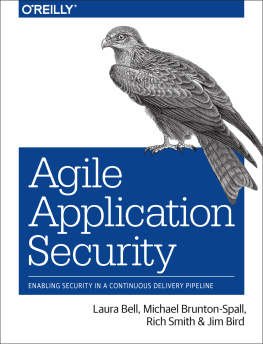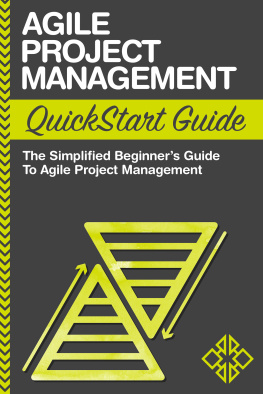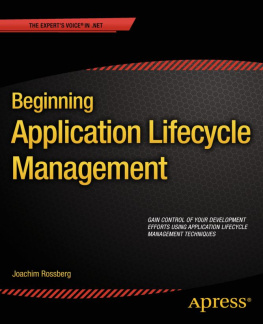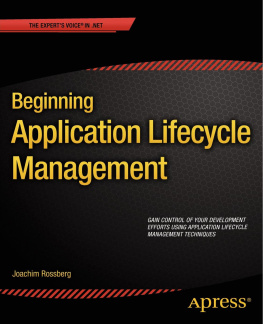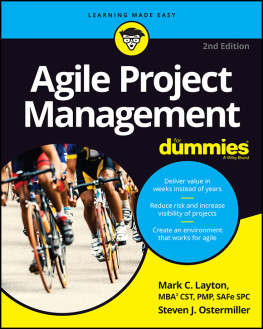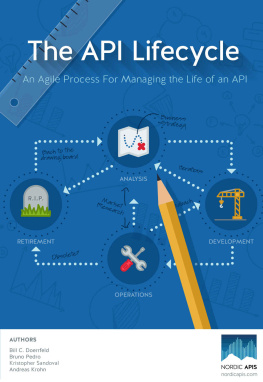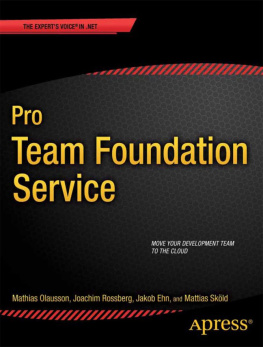About This E-Book
EPUB is an open, industry-standard format for e-books. However, support for EPUB and its many features varies across reading devices and applications. Use your device or app settings to customize the presentation to your liking. Settings that you can customize often include font, font size, single or double column, landscape or portrait mode, and figures that you can click or tap to enlarge. For additional information about the settings and features on your reading device or app, visit the device manufacturers Web site.
Many titles include programming code or configuration examples. To optimize the presentation of these elements, view the e-book in single-column, landscape mode and adjust the font size to the smallest setting. In addition to presenting code and configurations in the reflowable text format, we have included images of the code that mimic the presentation found in the print book; therefore, where the reflowable format may compromise the presentation of the code listing, you will see a Click here to view code image link. Click the link to view the print-fidelity code image. To return to the previous page viewed, click the Back button on your device or app.
Agile Application Lifecycle Management
Using DevOps to Drive Process Improvement
Bob Aiello and Leslie Sachs

Boston Columbus Indianapolis New York San Francisco Amsterdam Cape Town
Dubai London Madrid Milan Munich Paris Montreal Toronto Delhi Mexico City
So Paulo Sydney Hong Kong Seoul Singapore Taipei Tokyo
Many of the designations used by manufacturers and sellers to distinguish their products are claimed as trademarks. Where those designations appear in this book, and the publisher was aware of a trademark claim, the designations have been printed with initial capital letters or in all capitals.
The authors and publisher have taken care in the preparation of this book, but make no expressed or implied warranty of any kind and assume no responsibility for errors or omissions. No liability is assumed for incidental or consequential damages in connection with or arising out of the use of the information or programs contained herein.
For information about buying this title in bulk quantities, or for special sales opportunities (which may include electronic versions; custom cover designs; and content particular to your business, training goals, marketing focus, or branding interests), please contact our corporate sales department at or (800) 382-3419.
For government sales inquiries, please contact .
For questions about sales outside the U.S., please contact .
Visit us on the Web: informit.com/aw
Library of Congress Control Number: 2016936588
Copyright 2016 Pearson Education, Inc.
All rights reserved. Printed in the United States of America. This publication is protected by copyright, and permission must be obtained from the publisher prior to any prohibited reproduction, storage in a retrieval system, or transmission in any form or by any means, electronic, mechanical, photocopying, recording, or likewise. For information regarding permissions, request forms and the appropriate contacts within the Pearson Education Global Rights & Permissions Department, please visit www.pearsoned.com/permissions/.
ISBN-13: 978-0-321-77410-1
ISBN-10: 0-321-77410-8
Text printed in the United States on recycled paper at RR Donnelley in Crawfordsville, Indiana.
First printing, June 2016
In loving memory of:
Bobs mother and grandmother, two exceptional women who
encouraged him to embrace all of lifes challenges and develop
an inner compass for the surest path forward,
and
IT expert and dear friend, Ben Weatherall, a pillar in the CM
community who was always eager to share his best practices
and tirelessly promoted the value of a modified agilescrum
development methodology. As an editor, I appreciated and
chuckled along with our readers at the many zany characters
he would weave into his articles for CM Crossroads. He was
proud of his involvement with both professional associations,
such as the IEEE and ASEE (Association of Software
Engineering ExcellenceThe SEIs Dallas-based SPIN Affiliate),
and social and charitable organizations. An enthusiastic
resident of his Fort Worth, Texas, community, Ben was an
active participant in his local Shriners Car-vettes group and
could be counted on to lend a hand whenever their presence
was requested at an event. Ben was a man of deep faith and,
over the years, we had many engaging discussions about
matters much more significant than configuration management.
Each of these three individuals was dedicated to balancing
a strong work ethic with an equal commitment to their
personal relationships; we cherish their legacy.
Contents
Preface
This is an amazing, and perhaps chaotic, time to be involved with the technology industry. The demand for talent, skills, and commitment to excellence has never been higher. Developing software and systems has become a remarkably complex task, with many factors affecting the success of the development effort. Learning new development frameworks and adapting legacy systems to meet the need for continued growth and flexibility require the modern IT professional to be able to press forward, while understanding the limitations imposed by earlier conditions. Teams may be located in one specific war room or distributed across the globe and frequently working at different hours of the day, with varying languages, cultures, and expectations for how they will operate on a daily basis. The project itself might involve writing complex application software or customizing a vendor package as part of a systems (versus software) development effort. The competition for specialized technical resources motivates many organizations to allow flexible work arrangements, including telecommuting along with choosing office locations convenient to attract local candidates. Technology professionals must often choose between the demands of high-paying (and often stressful) opportunities and trying to maintain a comfortable work-life balance. The Internet has clearly become the backbone of commerce, and companies are expected to continuously align themselves with growing Web capabilities in order to achieve and maintain success.
Pragmatic Focus
This book focuses on the real world of creating and implementing processes and procedures to guide your software and systems delivery effort. The views expressed in these pages may make you feel uncomfortable, especially if you view yourself as an agile purist. We are going to challenge assumptions regarding the way things are being done today, and we are going to encourage you to participate in a discussion on how we can do a better job of developing software and systems. We are going to stipulate up front that our views may not always be applicable in every possible situation, but all that we write is based upon our real-world experiences or that which we have heard about from reliable sources. This is not a feel-good book about agile. This is a book about creating processes and procedures to guide you in overcoming the day-to-day challenges of developing complex software and systems. We look forward to hearing from you as you read through these chapters!
Successful organizations need to support complex technologies, most often with a significant Web presence. Even companies going out of business are expected to have a functioning Web presence capable of handling the peak transaction requirements of customers and other users. In practice, these complex development efforts necessitate effective processes and methodologies to meet both the demands of today and those that will surface in the future. This book will describe best practices for designing the appropriate application lifecycle management (ALM) processes necessary to successfully develop and implement complex software systems, whether your team is writing the code or customizing a system that you have purchased from a vendor. We will discuss both agile and non-agile methodologies to empower the reader to choose the best approach for your organization and the project that you are trying to complete. Our goal is to increase and enhance the readers understanding and ability to apply these principles and practices in your own environment. We often work in the imperfect world of having to support lifecycle methodologies that are not always optimal. In fact, we are usually called in when things get really bad and an organization needs to figure out how to incrementally improve processes to improve quality and productivity. In our opinion, the most effective methodology to emerge in the last decade has been agile.



